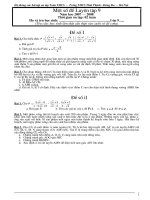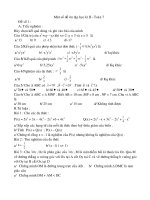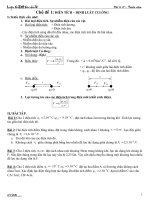Chủ đề: Ôn tập cấu trúc "Used to"
Bạn đang xem bản rút gọn của tài liệu. Xem và tải ngay bản đầy đủ của tài liệu tại đây (111.08 KB, 4 trang )
<span class='text_page_counter'>(1)</span><div class='page_container' data-page=1>
<b> Chủ đề: Ôn tập cấu trúc “used to”</b>
<b> Môn: Tiếng Anh 7</b>
<b>I. Lý thuyết: * Used to</b>
<b>1. Cách dùng</b>
<b>Cấu trúc used to hay cấu trúc used to V được sử dụng để nói về một thói quen, hành động,</b>
sự kiện hoặc trạng thái đã từng xảy ra trong q khứ và khơng cịn xảy ra trong hiện tại
nữa. Đơi khi nó được dùng để nhấn mạnh về sự khác biệt giữa hiện thực và quá khứ.
<b>2. Công thức</b>
<b>Khẳng định (+)</b> S <b>Used</b> to V + O
<b>Phủ định (-)</b> S <b>Did</b> not Use to V + O
<b>Nghi vấn (?)</b> <b>Did</b> S Use to V + O?
<i><b>Ví dụ:He used to be a long distance runner when he was young.</b></i>
<b>There used to be a cinema here.</b>
<b>I didn’t use to go swimming.</b>
<b>She didn’t use to drink that much coffee.</b>
<b>Did he use to smoke?</b>
<b>Did you use to eat meat before becoming a vegetarian?</b>
<b>Lưu ý:</b>
<b>1. Phủ định của cấu trúc used to V có thể được viết dưới dạng used not to V. </b>
<b>Ví dụ:I use not to go swimming.</b>
<b> She use not to drink that much coffee.</b>
<b>2. Khơng có thì hiện tại với cấu trúc used to V trong tiếng Anh. Để nói về thói quen trong </b>
<b>hiện tại, ta dùng các trạng từ tần suất (usually, always, often, never,...)</b>
<b>3. Used hay use?</b>
<b>Khi trong câu khơng có “did”, ta dùng “used to” (có d)</b>
<b>Khi trong câu có “did”, ta dùng “use to” (khơng có d)</b>
<b>*Mở rộng: Be used to V-ing </b>
</div>
<span class='text_page_counter'>(2)</span><div class='page_container' data-page=2>
Cấu trúc be used to V-ing được sử dụng để diễn tả ai đó đã từng làm 1 việc gì đó nhiều lần
và đã có kinh nghiệm, khơng cịn lạ lẫm với việc đó nữa.
<b>2.Cơng thức</b>
<b>Khẳng định (+) S</b> be (is, are,…) <b>used</b> to V-ing/danh từ.
<b>Phủ định (-)</b> S <b>be (is, are,…) not used</b> to V-ing/danh từ.
<b>Nghi vấn (?)</b> <b>Be (is, are,…) S</b> used to V-ing/danh từ?
<i><b>Ví dụ (+):I am used to being lied to</b></i>
<b>He is used to working late.</b>
<b>(-): He wasn’t used to the heat and he caught sunstroke.</b>
<b>We aren’t used to taking the bus.</b>
<i><b> (?):Is she used to cooking?</b></i>
<b>Are you used to fast food?</b>
<b>*Cấu trúc Get used to V-ing</b>
<b>1.Cách dùng:</b>
<b>Cấu trúc get used to V-ing được sử dụng để diễn tả ai đó đang dần quen 1 vấn đề hoặc sự </b>
việc nào đó.
<b>2.Cơng thức:</b>
<b>Khẳng định (+)</b> S <b>get used</b> to V-ing/danh từ.
<b>Phủ định (-)</b> S <b>do</b> not get used to V-ing/danh từ.
<b>Nghi vấn (?)</b> <b>Do</b> S get used to V-ing/danh từ?
<i><b>Ví dụ(+):You might find it strange at first but you will soon get used to it_Bạn có thể cảm</b></i>
<i>thấy lạ lẫm lúc đầu nhưng rồi bạn sẽ quen với điều đó</i>
<i><b>After a while Jane didn’t mind the noise in the office; she got used to it_Sau một thời gian </b></i>
<i>Jane đã khơng cịn cảm thấy phiền bởi tiếng ồn nơi cơng sở. Cơ ấy đã quen với nó</i>
</div>
<span class='text_page_counter'>(3)</span><div class='page_container' data-page=3>
<i><b>We couldn’t get used to the noisy neighborhood, so we moved_Chúng tôi đã không thể </b></i>
<i>quen với tiếng ồn của hàng xóm, vậy nên chúng tơi chuyển đi</i>
<i><b>(?):Has your sister gotten used to his new boss?_Em gái của bạn đã quen với sếp mới </b></i>
<i>chưa?</i>
<i><b>Have Tom got used to driving on the left yet?_Tom đã quen với việc lái xe bên tay trái </b></i>
<i>chưa?</i>
<b>Lưu ý</b>
<b>1. Cả hai cấu trúc ‘be used to’ và ‘get used to’ đều theo sau bởi danh từ hoặc danh động từ</b>
(động từ đuôi -ing)
<b>2. ‘Be used to’ và ‘get used to’ có thể được dùng ở tất cả các thì, chia động từ phù hợp </b>
cho từng thì. Ví dụ:
<b>You will soon get used to living alone.</b>
<b>When we lived in Bangkok, we were used to hot weather.</b>
<b>I have been getting used to snakes for a long time.</b>
<b>II.Bài tập áp dụng:</b>
<b>Bài 1: Điền “used to”vào chỗ trống</b>
1. I didn’t … do much skiing.
2. We … walk to school when we were children.
3. They not… let women join this club.
4. There … be a lake here years ago.
5. John didn’t … like Mary when they were teenagers.
6. When … they…. live here?
7. Why did you … use this old photocopier?
8. We never … have electricity in our house.
9. I hardly ever … have time for going out.
10. Did they … let you smoke in cinemas?
<b>Bài tập 2: Chọn đáp án đúng:</b>
1. When I started to work here I needed a lot of help, but now I (am used to doing/ ued to
do/get used to doing) all the work on my own.
2. He (was used to reading/used to read/got used to reading) several books a month, but he
doesn’t have time any more.
</div>
<span class='text_page_counter'>(4)</span><div class='page_container' data-page=4>
4. Don’t worry, it’s a simple program to use. You (are used to/will get used to/used to use)
it in no time, I’m sure.
5. When I had to commute to work every day I (used to get up/used to getting up) very
early.
6. I’m afraid I’ll never (get used to living/used to live/got used to living) in this place. I
simply don’t like it and never will.
7. Whenever we came to Coventry we always (used to stay/got used to staying) in the
Central Hotel. We loved it.
8. When Pete Smith was the head of our office everything (got used to be/used to be/was
used to being) well organized. Now it’s total chaos here.
9. Mr Lazy was shocked when he joined our busy company because he ( wasn’t used
to/didn’t use to) doing much work everyday.
</div>
<!--links-->









